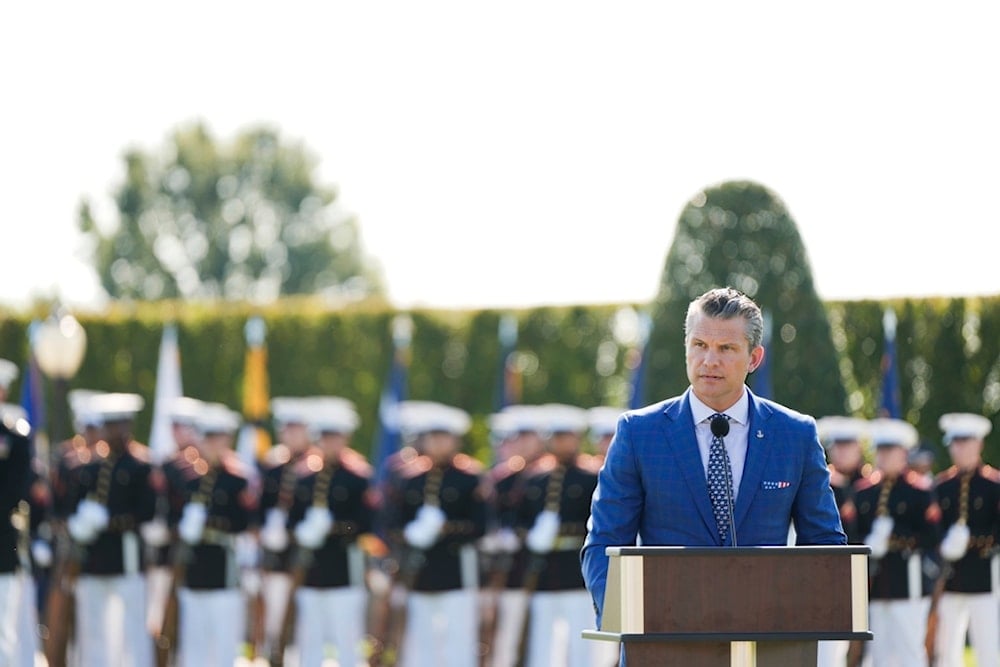Hegseth's sudden order for generals sparks alarm at Pentagon: WP
Defense Secretary Pete Hegseth's unprecedented order summoning nearly all US generals and admirals to Quantico has fueled alarm.
-

War Secretary Pete Hegseth speaks during the POW/MIA National Recognition Day Ceremony at the Pentagon, Friday, Sept. 19, 2025, in Washington (AP Photo/Julia Demaree Nikhinson)
The Washington Post on Thursday reported that War Secretary Pete Hegseth has instructed hundreds of US generals and admirals to assemble next week at Marine Corps Base Quantico in Virginia, a sudden directive that has unsettled the military ranks and heightened speculation about the Trump administration's intentions.
The order, issued earlier this week, requires nearly all senior commanders holding the rank of brigadier general or higher, including those stationed in conflict zones and across Europe, the Middle East, and the Asia-Pacific, to appear in person. Top officers in staff roles are exempt. Several officials said they could not recall any precedent for such a sweeping summons.
"People are very concerned. They have no idea what it means," said one individual familiar with the decision. Another officer asked, "Are we taking every general and flag officer out of the Pacific right now? All of it is weird." A third said, "You don't call GOFOs leading their people and the global force into an auditorium outside D.C. and not tell them why/what the topic or agenda is."
Pentagon spokesman Sean Parnell confirmed the gathering, saying only that Hegseth "will be addressing his senior military leaders early next week." He offered no explanation for the meeting's purpose.
Pentagon Power Purge
The unprecedented call-up comes amid Hegseth's aggressive restructuring of the Pentagon. He has ordered a 20 percent cut in general and flag officers, fired senior commanders without public justification, and pushed to rebrand the Department of War as the Department of War. Critics argue these moves reflect a more combative, politically driven posture.
In recent months, Hegseth dismissed Lt. Gen. Jeffrey Kruse of the War Intelligence Agency, Vice Adm. Nancy Lacore of the Navy Reserve, and Rear Adm. Milton Sands, a Navy SEAL officer overseeing special warfare operations. Earlier firings included Joint Chiefs chairman Gen. Charles Q. Brown Jr., Navy chief Adm. Lisa Franchetti, Coast Guard commandant Adm. Linda Fagan, and Air Force vice chief Gen. James Slife, a pattern that disproportionately removed women from the highest ranks.
Beyond personnel changes, Hegseth has taken steps to dismantle long-standing Pentagon institutions. Last week, he dissolved the War Advisory Committee on Women in the Services (DACOWITS), dismissing it as a promoter of a "divisive feminist agenda." He has also rolled back diversity, equity, and inclusion programs while touting a "warrior ethos" approach.
Read more: Pentagon codifies restrictions on think tank events
Pentagon Power Struggle
His tenure has been marred by controversies over secrecy and operational security. Earlier this year, Hegseth faced backlash for using Signal group chats to share sensitive military planning details, including, allegedly, with personal contacts like his wife and brother, prompting investigations and the resignation of his chief of staff. Civil society watchdogs have since sued the Pentagon for potentially violating federal records laws.
At the same time, press freedom advocates accuse Hegseth of orchestrating a crackdown on Pentagon media access, forcing journalists to sign restrictive pledges and curbing traditional press availability. Critics describe these measures as censorship aimed at controlling narratives around the military.
Meanwhile, administration officials are finalizing a new national War strategy that prioritizes homeland War over external threats, reversing years of focus on China. Some believe this shift could feature prominently in Hegseth's Quantico address.
With roughly 800 generals and admirals worldwide, the order to bring nearly all into one location at short notice has raised both security and practical concerns. "This is not how this is done," said one frustrated official, echoing the unease rippling through the US military leadership.

 4 Min Read
4 Min Read








